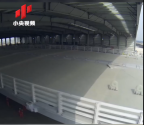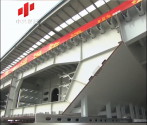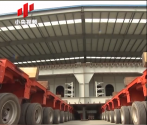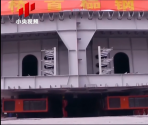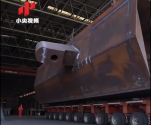You are using an out of date browser. It may not display this or other websites correctly.
You should upgrade or use an alternative browser.
You should upgrade or use an alternative browser.
CV-18 Fujian/003 CATOBAR carrier thread
- Thread starter Jeff Head
- Start date
View attachment 68821
View attachment 68822
View attachment 68823
View attachment 68824
View attachment 68825
The above link shows a video of the vehicle that can move carrier blocks for construction.
In the video there are a few segments that shows these blocks, I am not sure if these are 003 blocks.
What can you tell from the video and the screen captures from above?
Interesting, but I don't know if these are parts of a carrier - IMO unlikely! - ... esp. the module in first three images looks more like being part of a bridge.
Early tests in the mid 00s indicated a 70% efficiency in converting input energy into kinetic energy of launched aircraft, vs 6% efficiency of steam catapults. But EMALS requires at least one additional energy conversion step: steam -> electricity at about 40% efficiency and additional turbine generators to make that happen.Does anyone know how hungry emals are in terms of power consumption?
Interesting calculation method.Early tests in the mid 00s indicated a 70% efficiency in converting input energy into kinetic energy of launched aircraft, vs 6% efficiency of steam catapults. But EMALS requires at least one additional energy conversion step: steam -> electricity at about 40% efficiency and additional turbine generators to make that happen.
Ship sized steam turbine has good time to deliver 25% efficiency, means the 70% efficiency from electricity-kinetic in reality no more than 17%.
Steam delivered from the reactor without any additional step, and that has extreme level of spare capacity. It means fraction percent increase in the speed of the ship will consume more energy than the change in catapult technology.
Only problem is the distilled water requirements, each launch require 1000 kg of steam, however the ship needs around 200-500 tons of water /day anyway, and the aircraft consume several times more fuel on each launch in mass.
So the distillation plant size doesn't decrease dramatically (or at all) due to the lack of steam catapult.
Yeah, steam is a form of integrated energy system.Steam delivered from the reactor without any additional step, and that has extreme level of spare capacity. It means fraction percent increase in the speed of the ship will consume more energy than the change in catapult technology.
The main advantage of EMALS is less about energy saved (which is negligible compared to the energy needed to propel the ship). Rather, its main advantage is in space-saving, as it doesn't require miles of dedicated piping, which is a great bonus as space always comes at a premium on warships.
Using electromagnets to also means having finer control over acceleration, which can be adjusted based on the mass and type of aircraft being launched, meaning lesser stresses on the airframes compared to steam catapults that just go wooooosh. However, EMALS maintenance looks to be an absolute nightmare.
Using electromagnets to also means having finer control over acceleration, which can be adjusted based on the mass and type of aircraft being launched, meaning lesser stresses on the airframes compared to steam catapults that just go wooooosh. However, EMALS maintenance looks to be an absolute nightmare.
Most likely the space saving and the maintenance issues interconnected.The main advantage of EMALS is less about energy saved (which is negligible compared to the energy needed to propel the ship). Rather, its main advantage is in space-saving, as it doesn't require miles of dedicated piping, which is a great bonus as space always comes at a premium on warships.
Using electromagnets to also means having finer control over acceleration, which can be adjusted based on the mass and type of aircraft being launched, meaning lesser stresses on the airframes compared to steam catapults that just go wooooosh. However, EMALS maintenance looks to be an absolute nightmare.
The steam require lot of space not because can't make smaller units with simpler technology, but it needs to be reliable and redundant to bring the required mean time between failure.
So most likely the EMALS in final robust and battlehardened form won't be as small, light and cheap as advertised.
TBH, i have to agree. These photos dont give out that much evidence, and are a pain in the eye to discern any details.I swear my vision is actually getting worse looking too much at Type 003 satellite imagery.
They can modulate the acceleration way more with EMALS to accomodate a wider variety of airframe weight, diminish over stressing and optimising launch speed. If the rest is the same, just that make it worth to have...Most likely the space saving and the maintenance issues interconnected.
The steam require lot of space not because can't make smaller units with simpler technology, but it needs to be reliable and redundant to bring the required mean time between failure.
So most likely the EMALS in final robust and battlehardened form won't be as small, light and cheap as advertised.
Very strange conclusion from you. Here is the USN data of their catapult.Most likely the space saving and the maintenance issues interconnected.
The steam require lot of space not because can't make smaller units with simpler technology, but it needs to be reliable and redundant to bring the required mean time between failure.
So most likely the EMALS in final robust and battlehardened form won't be as small, light and cheap as advertised.
Other drawbacks to the steam catapult include a high volume of 1133 m3, and a weight of 486 metric tons.
While the EMALS' figure is less than 425 and 225 repectively.
If you have a car that keeps breaking down, I wonder how could you make it more robust and reliable by patching it with more metal.
EMALS's initial problem is not going to be solved by making it larger and heavier. It will be either working or breaking within its current dimension.

